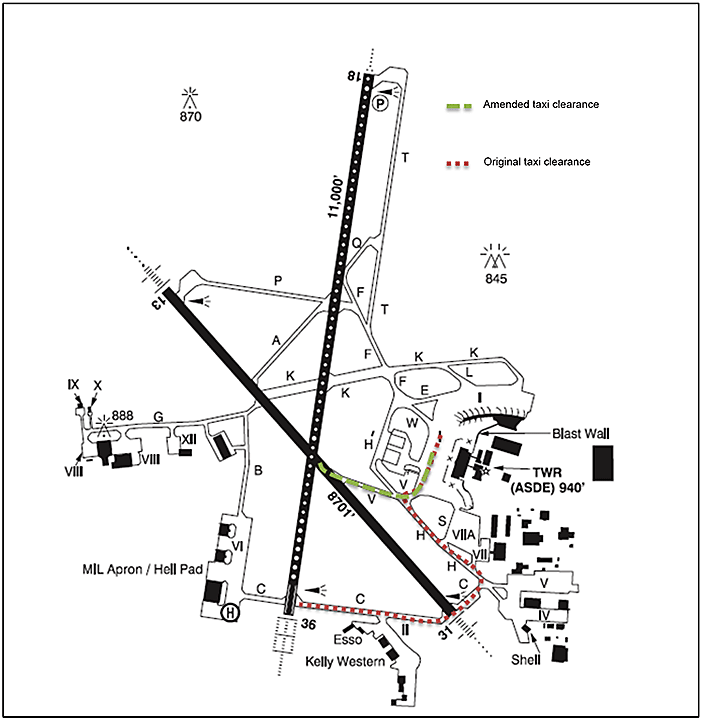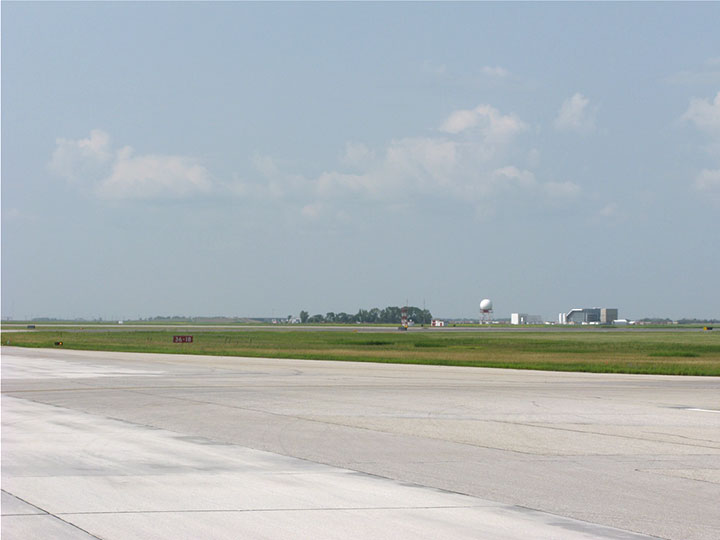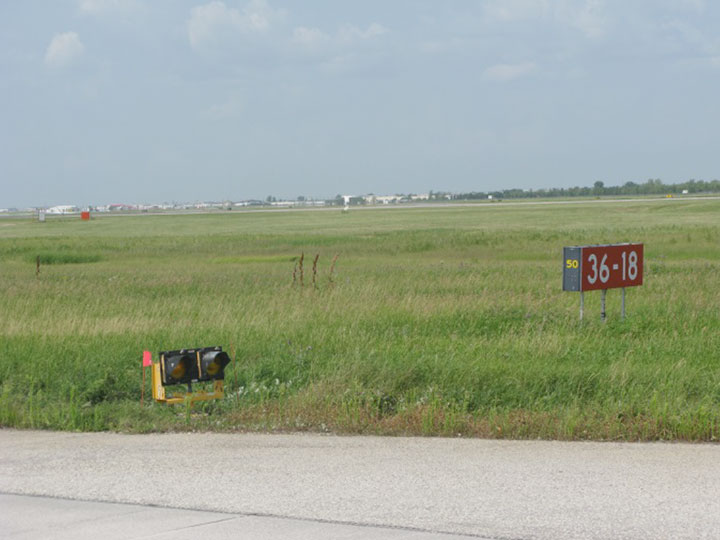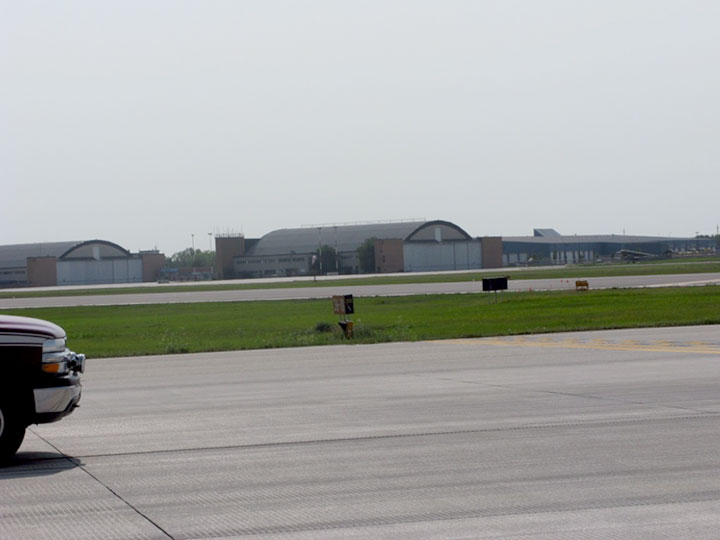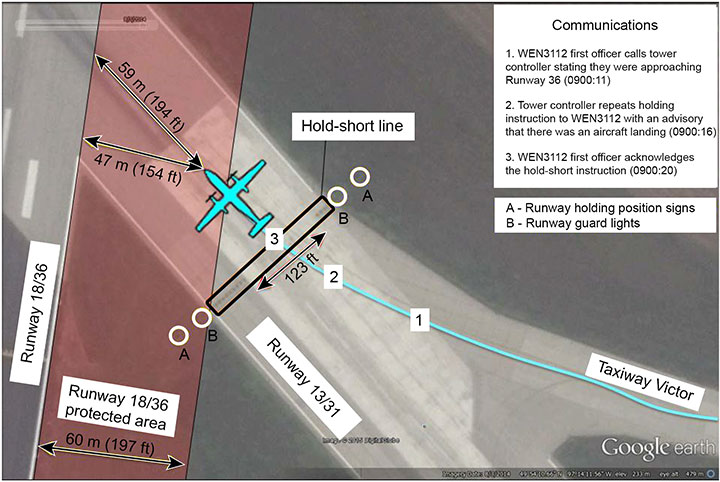Runway incursion
WestJet Encore Ltd.
de Havilland DHC-8-402, C-FOEN
Winnipeg Richardson International Airport
Winnipeg, Manitoba
The Transportation Safety Board of Canada (TSB) investigated this occurrence for the purpose of advancing transportation safety. It is not the function of the Board to assign fault or determine civil or criminal liability. This report is not created for use in the context of legal, disciplinary or other proceedings. See Ownership and use of content. Masculine pronouns and position titles may be used to signify all genders to comply with the Canadian Transportation Accident Investigation and Safety Board Act (S.C. 1989, c. 3).
Table of contents
Summary
On 04 August 2014, the ground controller at Winnipeg Richardson International Airport, Winnipeg, Manitoba, cleared the DHC-8-402 (registration C-FOEN, serial number 4440), operating as WestJet Encore Ltd. flight WEN3112, to taxi for departure via Runway 31 and to hold short of Runway 36. The WEN3112 crew acknowledged the clearance to hold short of Runway 36. At 0900 Central Daylight Time, the tower controller observed that WEN3112 had entered the Runway 36 protected area at the intersection with Runway 31 without a clearance. The tower controller then instructed a WestJet Boeing 737 700, operating as flight WJA318, which was on short final for Runway 36, to go around. WJA318 conducted a go-around and subsequently landed without further incident.
Factual information
History of the flight
On 04 August 2014, WestJet Encore Ltd. flight WEN3112 was ready to taxi from Apron 1 at Winnipeg Richardson International Airport (CYWG), Winnipeg, Manitoba. The flight crew consisted of a captain and a first officer. The first officer requested a taxi clearance from the CYWG ground controller at 0856Footnote 1 for departure to Thunder Bay, Ontario. The ground controller issued a clearance to taxi for Runway 36 via taxiways Victor, Hotel, and Charlie, then across Runway 31 to hold short of Runway 36. The first officer acknowledged the clearance, and the captain began taxiing the aircraft as cleared (Figure 1).
To shorten the taxi time, the first officer requested a new taxi clearance again for departure from Runway 36, but this time from the Runway 31 intersection. At 0858:13, the ground controller amended the taxi instructions to have WEN3112 taxi via Taxiway Victor, Runway 31 and hold short of Runway 36. The first officer correctly read back the amended taxi clearance, including the instruction to hold short of Runway 36.
At 0858:39, a WestJet Boeing 737 700, operating as flight WJA318, was approximately 5 nautical miles south of the runway when the tower controller cleared it to land on Runway 36.
The WEN3112 first officer switched to the tower frequency and advised the tower controller at 0900:11 that they were approaching Runway 36. At 0900:16, the tower controller repeated the instruction to hold short of Runway 36 with an advisory that there was an aircraft landing. The first officer acknowledged the hold-short instruction at 0900:20 (Appendix A – Runway incursion area).
The WEN3112 captain was aware that they were approaching the holding position while the first officer was communicating with the tower controller. The captain slowed the aircraft and visually scanned for the hold-short line painted on Runway 31, but did not see it and stopped the aircraft. Both pilots assessed their position to be an adequate distance from Runway 36.
The tower controller visually observed that WEN3112 had entered and stopped in the Runway 36 protected area, and confirmed the observation by use of the airport surface detection equipment (ASDE).Footnote 2 At 0900:34, the tower controller instructed WJA318 to go around and advised that an aircraft had entered the Runway 36 protected area. WJA318 complied with the go-around instruction.
WEN3112 was subsequently cleared for departure, and WJA318 landed uneventfully.
Personnel information
Records indicate that the WEN3112 flight crew was certified and qualified for the flight in accordance with existing regulations.
| Captain | First officer | |
|---|---|---|
| Pilot licence | Airline transport pilot licence (ATPL) | Airline transport pilot licence (ATPL) |
| Total flying hours | 4300 | 4150 |
| Hours on type | 500 | 71 |
| Hours in the last 7 days | 17.1 | 8.7 |
| Hours in the last 30 days | 35.1 | 61.6 |
| Hours in the last 90 days | 115.9 | 76.6 |
The captain was hired by WestJet Encore Ltd. in September 2013 as a first officer on the de Havilland DHC-8-402. The captain completed upgrade training in March 2014, and was promoted to captain on the de Havilland DHC-8-402 in April 2014.
The first officer was hired by WestJet Encore Ltd. in May 2014. The first officer completed all required training, including a line check on the de Havilland DHC-8-402 on 10 July 2014.
Both pilots were 3.8 hours into their current duty day at the time of the incursion. The flight crew had been off duty for over 18 hours prior to starting their day in Regina, Saskatchewan, and operated uneventfully from Regina to Winnipeg. The investigation determined that there was nothing to indicate that the captain's or first officer's performance was degraded by fatigue.
Aircraft information
The de Havilland DHC-8-402 is a 78-seat aircraft powered by 2 Pratt & Whitney Canada PW150A turboprop engines. Records indicate that the aircraft was certified, equipped, and maintained in accordance with existing regulations and approved procedures. Nothing was found to indicate that there was any aircraft system malfunction during the occurrence.
Meteorological information
At 0900, the aviation routine meteorological report (METAR) for CYWG was: wind 020° true at 3 knots (variable from 350° to 160° true), visibility 15 statute miles, few clouds at 9000 feet above ground level (agl), few clouds at 16 000 feet agl, scattered clouds at 22 000 feet agl, temperature 18°C, dew point 14°C, altimeter setting 30.16 inches of mercury. The prevailing weather was not considered a contributing factor in the occurrence.
Communications
Communication between the ground controller and the crew of WEN3112 was conducted on the CYWG ground frequency, 121.9 MHz. The initial calls, taxi instructions and request for change of departure point were understood by the controller and the pilots. Taxi clearances issued to WEN3112 included the instruction to contact the tower controller when holding short of Runway 36. The first officer acknowledged by reading back the hold-short instruction.
The WEN3112 first officer switched to the tower controller frequency of 118.3 MHz when approaching Runway 31 on Taxiway Victor. The tower controller repeated the instruction to hold short of Runway 36 and advised that an aircraft had been cleared to land. The first officer acknowledged once again by reading back the hold-short instruction.Footnote 3
Aerodrome information
CYWG is operated and maintained by the Winnipeg Airport Authority Inc. (WAA). The airport has 2 runways that intersect—Runway 13/31 and Runway 18/36—and a network of taxiways and aprons. Depending on which runway is active, the other runway can be used as a taxiway.
CYWG had undergone a Runway 18/36 construction project that started on 28 April 2014 and was completed on 31 July 2014. The scope of the construction project was to resurface Runway 18/36 and to conduct localized land drainage repairs. During the construction period, Runway 18/36 was closed, leaving only Runway 13/31 operational. The WAA had planned all scheduled maintenance of Runway 13/31 to occur before and after the Runway 18/36 construction.
A hazard identification and risk assessment (HIRA) for the construction project was conducted by airport stakeholders on 02 April 2014. The HIRA process identified a potential hazard regarding reduced visibility operations. A proposed risk control for this hazard was to repaint lines on Runway 13/31 prior to the closure of Runway 18/36. The HIRA also identified that single-runway operations would reduce the ability to conduct maintenance on the operational runway. The documented ongoing risk control for this hazard relied on routine inspections and maintenance to identify and mitigate deficiencies.
Routine airport inspections at CYWG are conducted by the WAA duty airport manager and the airfield maintenance staff at least every 24 hours. The routine inspections focus on identification and removal of foreign object debris, ensuring the proper functionality of the aerodrome lighting, and on general inspection of all aspects and conditions of airfield equipment. Personnel conducting these inspections relied on their training and experience in aerodrome standards requirements because no checklists or documented procedures existed. In changing conditions, such as during snow events, the inspection frequency is increased substantially.
The construction plan had designated the construction zone to be the width of Runway 18/36 plus 100 feet on each side. Prior to reopening Runway 18/36 on 31 July 2014, WAA staff conducted an inspection to ensure the runway was ready for operational use. The inspection was limited to the construction zone and did not include an inspection of conditions outside the construction zone.
Runway protected areas
A runway protected area is “the area around an active runway established to protect aircraft taking off and landing from taxiing aircraft and ground traffic.”Footnote 4 Defences consisting of hold-short lines painted on taxiways and runways, runway holding position signs, and/or runway guard lights (RGL) can be installed to indicate a stopping position that prevents incursion into the runway protected area when a hold-short instruction has been issued to pilots or vehicle operators.
At CYWG, the runway protected areas extend 60 m outward from the edge of the active runway (Appendix A). Every taxiway-to-runway and runway-to-runway intersection at CYWG was equipped with all 3 defences listed above to identify hold-short positions outside the 60 m width of runway protected areas. However, the hold-short line southeast of Runway 36 on Runway 31 was significantly degraded. A satellite image, taken the day before the occurrence, shows the hold-short line was missing approximately 123 feet of paint (Appendix A).
Line painting on taxiways and runways at CYWG is performed by airfield maintenance staff. Although the paint is generally applied in spring and fall, there are no firm dates or schedules for paint application because the temperature must be consistently above 10°C and the surface must be dry. The hold-short line on Runway 31 was last painted on 19 October 2013. While the HIRA process had highlighted the need to repaint the lines prior to the Runway 18/36 closure on 28 April 2014, the spring weather conditions had not been suitable at the time. Once Runway 18/36 was closed, Runway 13/31 was the only available runway; consequently, the planned spring painting of Runway 13/31 did not occur.
WAA staff subsequently rescheduled painting of Runway 13/31 for 05 August 2014, after the reopening of Runway 18/36. Inspections of Runway 13/31 after the opening of Runway 18/36 on 31 July 2014 did not identify the degraded condition of the hold-short line. The line was repainted by airport staff on 05 August 2014, as scheduled, before the TSB had requested pictures of the hold-short line condition.
Runway holding position signs are also located at runway-to-runway and taxiway-to-runway intersections. These signs identify the runway that a taxiing aircraft or ground vehicle is approaching. “Holding position signs are also installed at runway-to-runway intersections when one runway is regularly used as a taxi route or when simultaneous intersecting runway operationsFootnote 5 are authorized.”Footnote 6 At runway-to-runway intersections, the holding position signs are installed on each side of the runway. Holding position signs were installed at the intersection of Runway 31 and Runway 36, and conformed to existing standards (Photo 1, Photo 2, and Photo 3).
CYWG has a pair of RGLs installed adjacent to the hold-short lines along both runways. They consist of 2 yellow alternately illuminating unidirectional lights to provide additional means of identifying the holding position.
RGLs should be aligned to focus to the centre point of the runway or taxiway, 45 to 60 m from the RGLs. This alignment results in the lights being aimed 37 to 45 degrees inward toward the centre of the runway or taxiway. TSB investigators examined the RGLs on both sides of the hold-short line on Runway 31 at the intersection of Runway 36, and observed that the left RGL was orientated approximately 15 degrees away from the runway. This misalignment was not identified in the daily airport inspections.
The RGL intensity is adjusted using a control panel located in the CYWG control tower. Generally, the RGLs for Runway 18/36 are on continually and can be set to intensity 1, 2 or 3, with 1 being the lowest intensity and 3 being the highest. Lighting system records showed that the RGLs were set to intensity 1 on 31 July 2014, and remained unchanged until after the occurrence. The Winnipeg Tower Unit Operations Manual states “Runway Guard Lights shall be operated at all times, with intensity 3 selected during daylight”, but there was no procedure for the controllers to verify the RGL intensity settings.
Airport surface detection equipment
The CYWG control tower is equipped with ASDE, which displays information to the controllers regarding the position and movement of objects on the airport surfaces. The ASDE system screen also displays the approximate location of hold-short lines.
TSB analysis of ASDE recordings showed the ground movement of WEN3112 to have been as follows: at 0900:18, as it was slowing, the aircraft breached the hold-short line; and at 0900:26, WEN3112 stopped with the nose of the aircraft approximately 47 m from the edge of Runway 36 (Appendix A).
Flight recorders
Both aircraft were equipped with cockpit voice recorders (CVR). However, since the TSB was only notified of the occurrence the following day, the CVR data had been overwritten and, therefore, was not available to the investigation.
Flight data recorders (FDR) were installed in both aircraft and were sent to the TSB laboratory for data recovery and analysis. The WEN3112 FDR recorded latitude and longitude from the flight management system; however, the resolution and accuracy was not adequate to reliably determine the position of the aircraft on the airport surface. The FDR data for WJA318 allowed for an accurate determination of the aircraft's flight path.
TSB Watchlist
Risk of collision on runways is a 2014 Watchlist issue
The Watchlist is a list of issues posing the greatest risk to Canada's transportation system; the TSB publishes it to focus the attention of industry and regulators on the problems that need addressing today.
As this occurrence demonstrates, there is an ongoing risk of aircraft colliding with vehicles or other aircraft on the ground at Canadian airports.
The TSB has called for improved procedures and enhanced collision warning systems to be implemented at Canada's airports.
TSB laboratory reports
The following TSB laboratory report was completed in support of this investigation:
- LP154/2014 – FDR [flight data recorder] / Radar Data Analysis
Analysis
The pilots were trained and certified in accordance with existing regulations, and the aircraft was operating normally and had no defects. The investigation revealed that communication and weather were not contributing factors. Therefore, the analysis will focus on the condition of the hold-short line and the incursion into the runway protected area.
Hold-short line
On 03 August 2014, when the satellite image was taken, the hold-short line painted on Runway 31 southeast of Runway 36 was significantly degraded, with 123 feet of the line missing (Appendix A). The missing portion of the hold-short line was located on the centre section of the runway; the line was still present on the edges of the runway. As a result, the crew of WEN3112 did not see it and stopped in the runway protected area.
At CYWG, paint is usually applied in the spring and fall—an interval of approximately 6 months. In this instance, 290 days had elapsed since the last paint application on the hold-short line, and the increased interval resulted in a degradation of the paint. Increased traffic on the centre section of Runway 13/31 due to the closure of Runway 18/36 likely contributed further to the degradation of the line.
Before the construction project on Runway 18/36 began, CYWG stakeholders conducted a hazard identification and risk assessment (HIRA). However, action to mitigate risks associated with single-runway operations was reliant on the existing daily inspections conducted by the Winnipeg Airport Authority Inc. (WAA). These inspections relied on the observations, training, and experience of the airport duty manager and the airfield maintenance staff conducting them. If there are no checklists or documented procedures for airport inspections, then there is an increased risk that non-compliance with regulatory requirements or safety deficiencies will not be identified. The daily inspections did not identify the degraded condition of the hold-short line, allowing continued use of the hold-short position.
Incursion into the runway protected area
The taxi route led WEN3112 to Runway 31 directly toward the degraded portion of the hold-short line. The first officer's attention was likely diverted from searching for the hold-short line to communicate with the tower controller. The captain was actively looking for the hold-short line as the primary reference for the hold-short position and was slowing the aircraft. The captain did not see the remaining paint of the hold-short line because it was located on the edges of Runway 31.
The aircraft was taxiing straight ahead on the centreline, and both pilots assessed that they had stopped at an adequate distance from Runway 36. The aircraft stopped 59 m from the active runway (Appendix A). However, due to the angle between Runway 31 and the active Runway 18/36, the aircraft was only 47 m from the edge of Runway 18/36 when it stopped within the 60 m runway protected area. The crew of WEN3112 did not identify the hold-short position, and taxied into and stopped in the runway protected area.
Runway holding position signs were installed to indicate the hold-short position. However, the orientation of the runway holding position signs was optimized for traffic on Runway 31, which likely contributed to the pilots not identifying the hold-short position. As the aircraft approached Runway 31 from Taxiway Victor, the viewing angles of the holding position signs were more acute (Photo 1, Photo 2, and Photo 3), and the distance to the left sign was greater thus reducing the pilots' ability to notice the signs.
In addition to the runway position signs, there were runway guard lights (RGL) installed to indicate the hold-short position. Since the left RGL was aimed 15 degrees away from Runway 31, this RGL was not visible to the pilots along the taxi route. Furthermore, the orientation of the right RGL relative to the aircraft's position and the reduced RGL intensity setting likely contributed to the pilots not identifying the hold-short position.
Findings
Findings as to causes and contributing factors
- The hold-short line painted on Runway 31 southeast of Runway 36 was significantly degraded, with 123 feet of the line missing. As a result, the crew of WEN3112 did not see it and stopped in the runway protected area.
- The daily airport inspections at Winnipeg Richardson International Airport (CYWG) did not identify the degraded condition of the hold-short line, allowing continued use of the hold-short position.
- The orientation of the runway holding position signs was optimized for traffic on Runway 31, which likely contributed to the pilots not identifying the hold-short position.
- The fact that the left runway guard light (RGL) was aimed 15 degrees away from Runway 31, the orientation of the right RGL relative to the aircraft's position, and the reduced RGL intensity setting likely contributed to the pilots not identifying the hold-short position.
Findings as to risk
- If there are no checklists or documented procedures for airport inspections, then there is an increased risk that non-compliance with regulatory requirements or safety deficiencies will not be identified.
Safety action
Safety action taken
Winnipeg Airport Authority Inc.
On 05 August 2014, the Winnipeg Airport Authority Inc. (WAA) repainted the degraded hold-short line on Runway 31 and realigned the runway guard light located on the left side of Runway 31 southeast of Runway 36. The WAA has also incorporated new procedures for return-to-service inspections and computer-based inspection tracking software that contains checklists and intervals for specific airfield elements inspections.
This report concludes the Transportation Safety Board's investigation into this occurrence. the Board authorized the release of this report on . It was officially released on .
